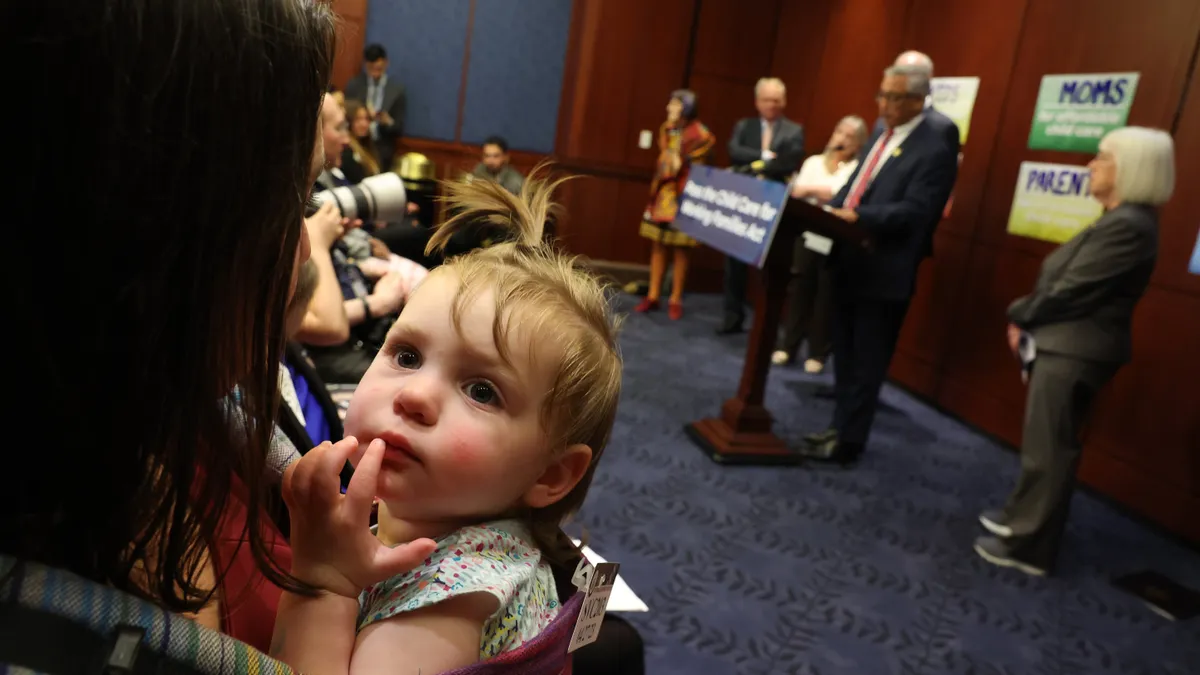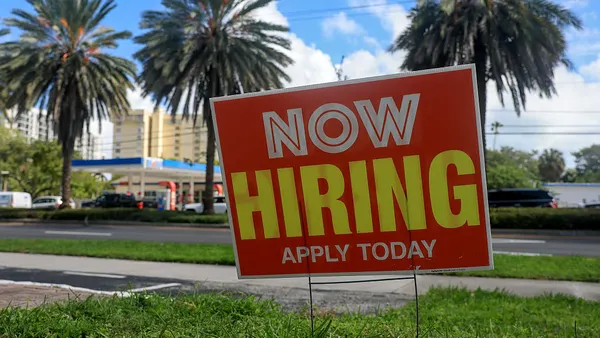Federal regulators spotlighted Thursday workers with gaps in their employment history, a diverse segment of workers for whom obtaining equal employment opportunity is “much harder,” according to Charlotte Burrows, chair of the U.S. Equal Employment Opportunity Commission.
Burrows co-hosted a virtual event April 28 with Jenny Yang, director of the Office of Federal Contract Compliance Programs, as part of the HIRE initiative, an interagency effort to remove barriers to recruitment and hiring. The discussion focused on four groups that have struggled with employment gaps during the pandemic: caregivers, older workers, workers with disabilities and workers with criminal backgrounds.
Members of each group bring their own set of unique skills to the workplace, speakers said, and they could help employers meet their hiring goals in a competitive market. But first, employers may need to adjust their policies and processes to break down the barriers each group faces.
A ‘waterfall of prejudice’
Working parents have been a focus for analysts throughout the pandemic. The pressures of raising a family can lead to employment gaps for any parent, but such gaps disproportionately affect women of color, particularly those in low-wage jobs, said Elizabeth Gedmark, vice president at the nonprofit A Better Balance.
Birth parents, for example, can be pushed off the job even when they are pregnant, and some are pushed off of multiple jobs during the same pregnancy. “This can often be the start of a downward spiral of financial insecurity,” Gedmark said. “Just because you can get a job doesn’t mean you can keep that job.” Furthermore, different jobs may not provide the same level of access to health benefits, and changing jobs may mean losing access to leave under the Family and Medical Leave Act.
When deciding to return to the workforce, caregivers of all sorts may fear disclosing the cause of resume gaps, Gedmark said, as this may invite stereotypes or discrimination. Some, she continued, do not even bother applying to jobs they believe would be hostile to caregivers.
Similarly, workers who have a disability face a conundrum during the interview process, according to Eve Hill, partner at law firm Brown Goldstein Levy. Under the Americans with Disabilities Act, covered employers are prohibited from asking candidates whether they have a disability. But should the employer ask the candidate to explain a resume gap, the candidate may need to bring up the subject anyway.
Such disclosures can lead to a “waterfall of prejudice,” Hill said. Employers may have a fear of disability, or a fear that people with disabilities who took time off from work in the past will be unreliable or otherwise require costly or unreasonable accommodations. Given that the pandemic may exacerbate pre-existing disabilities or influence new ones, including conditions such as long COVID-19 or those related to mental health, a person’s ability to work can be significantly impacted, Hill continued.
Employers also may overlook candidates with a criminal history, even if they’ve implemented a “ban the box” approach that nixes questions about criminal history, said Teresa Y. Hodge, president at Mission: Launch, Inc. That’s because a background check could still reveal the same information. And should criminal history turn up in a background check, employers may decide it’s easier to say no to the candidate than have a discussion with them.
“The negative effects of conviction rarely end when people have completed their sentence,” Hodge said. “This one piece of data is denying people access to opportunity.”
In the months after the World Health Organization declared COVID-19 a pandemic, economists shared forecasts that the resulting wave of layoffs and safety concerns could spark involuntary retirements among older workers. That’s problematic, according to Heather Tinsley-Fix, senior advisor, financial resilience at AARP, because it can often take these workers much longer to return to the workforce at the same salary they had prior to an involuntary exit.
Older workers face ageism and age discrimination that “remain stubbornly with us,” Tinsley-Fix said, but they also have to contend with a variety of changes to the job application process. Hiring now may be conducted exclusively online and through several different platforms. Candidates may be asked to take assessments or play games as part of the process or submit their own created videos, even before they’re granted a formal interview.
It’s a loss for companies, Tinsley-Fix said, because older workers bring with them both specific knowledge related to their fields as well as soft skills that are not easily automatable, including critical thinking, analysis, empathy and relationship building, among others.
What these workers bring to the table
Speakers noted the varied skills each of these groups can provide. Hill spoke about her experiences with employers who hired people with disabilities: these workers had “a level of loyalty that employers were stunned to find,” she said. Moreover, accommodations granted to these workers, such as simpler and clearer signage, had the effect of reducing workplace accidents overall.
Everyday experiences can directly tie into employees’ work. “People with disabilities solve more problems before they get to work than most of us solve in a week,” Hill said.
Past experience also helps those who’ve been formerly incarcerated. “In many cases, we’re running the facilities where we’re being held,” Hodge said. “In some circumstances, we’re able to continue our education while we’re being held.”
Hodge noted that formerly incarcerated persons are not a monolith, and that each brings unique skill sets to prison. Many have experience with soft skills, problem solving and entrepreneurial thinking. “This is a talent pool that can really help employers grow their business,” she said.
Caregivers, meanwhile, gain firsthand experience in patience, diligence, resilience and time management, said Gedmark, who added that caregiving is “not time off, it’s just difficult work that’s unpaid.”
Caregivers also know how to be advocates for their colleagues, she continued, because they often are tasked with speaking up for their loved ones. Gedmark gave the example of one mother who organized and advocated with a group of neonatal intensive care unit patients against one hospital’s practice of charging the NICU patients parking fees. The group was able to convince the hospital to waive those charges. “What employer wouldn’t want that person on their team?” Gedmark said.
What HR can do
Recruiters may note that resources to reach out to these groups already exist, in some cases. AARP’s job board can help employers find experienced workers, Tinsley-Fix said. Hill said employers seeking to expand their searches to workers with disabilities can reach out to disability student offices at educational institutions as well as disability and health group organizations. Current employees who are part of these groups can provide referrals.
Communication plays a part, too. Employers often leave disability out of their diversity, equity and inclusion statements, Hill said, despite the intersectionality workers with disabilities bring to the workplace. And employers that seek people with criminal backgrounds can take a big step toward recruiting this contingent simply by stating that they are a fair chance or second chance employer, Hodge said; “No one wants to be told over and over and over again that they’re not welcome after going through the daunting process of applying.”
More extensively, HR can perform a deep dive of the organization’s hiring process. Job descriptions, for example, may contain language that discourages certain groups from applying. Phrases such as “recent college graduate,” “high-energy” and “fast-paced” can subtly indicate to older workers that they should not bother to apply, Tinsley-Fix said. Legacy processes and filters also may be screening out patients who don’t have a college degree, or applications may ask for a date of birth or graduation date.
Unnecessary physical requirements may screen out people with disabilities, Hill said, such as requirements that candidates be able to lift 50 pounds. She noted that employers also might check the accuracy of requirements that candidates need a drivers’ license. In that example, there may be other methods by which an employee can move from place to place or from worksite to worksite.
Next, HR might reevaluate the recruitment team itself. Employers, according to the panel, should assess whether their interview panels contain diverse individuals, including older workers, workers with disabilities and other categories. Hill said she recommended that employers ensure recruiters undergo disability implicit bias training, while Hodge said recruiters may need training on how to have empathetic conversations about an employee’s past convictions or criminal background.
Some aspects of the hiring process can be directly overhauled to prepare for certain candidate groups. For example, HR teams can work to ensure accommodations are available to managers when they are needed ahead of time, Hill said.
External groups also may help. Hodge said employers could hire professionals that work specifically with formerly incarcerated persons and workers with criminal backgrounds to assess whether a given candidate is a fit for a particular job. When it comes to making hiring decisions for these candidates, Hodge said employers should “only deny an employee when it makes sense.”
Lastly, multiple speakers recommended flexible work policies as a gateway to inclusivity. Tinsley-Fix said employers could experiment with models such as returnships — recently adopted by big names like Amazon — to give older workers a “get-to-know-you period” that helps an organization determine whether the employee is a good fit. Part-time or consultant positions could also provide more flexibility to older candidates, she added.
Flexible time off also may be essential to candidates with criminal backgrounds, Hodge said, as they may have to meet with a parole officer, or they may be on probation. Employers can ensure that these workers can clock in early or work late, depending on the timeline of when the work needs to be done.
Caregivers, Gedmark said, may need flexibility to ensure they can make doctor’s appointments. Flexibility also may be built into hiring questionnaires, as caregivers may be hesitant to check a box or respond to a prompt about their availability. According to Gedmark, some caregivers fear that if they do not indicate that they are available to work at all times, they will not receive enough hours to pay their bills



















